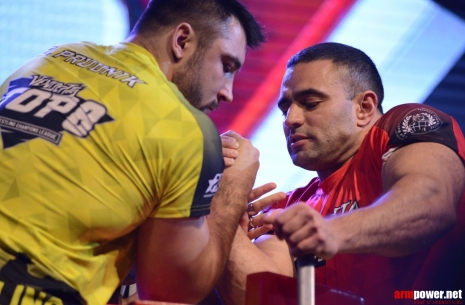
Rustam Babaev is not only a successful athlete, but also a professional trainer who trained a large team. What is its solidity? Rustam shared some technical secrets with readers. ()
Rustam, does professional career hinder coaching?
- On the one hand, these activities take time and energy. But, on the other hand, I am constantly looking for more effective methods of developing physical qualities as well as avoiding all kinds of injuries. And it helps us all. Of course, I pay more attention to those guys who really try and want to achieve something more. I think every coach does that. And I think this is normal.
Can you explain why the majority of successful hookers who actually pull “in a deep hook” change their movement to a more pulling one over time?
– A fight in a deep joint over time leads to serious injuries. And it concerns everyone. But as practice shows, everyone who can win this way believes that he is not everyone. And if the joint in his hand is unrealistically strong, he can even reach the level of a world champion. But at some stage the injury will happen. I only start from my long-term observations as an athlete and coach. And since it becomes impossible to fight for injury, the athlete involuntarily begins to work with auxiliary muscles in the direction in which it is more efficient and comfortable. Naturally, this pulling movement arises. This leads to an improvement in technique. Therefore, from the very start, the beginner needs to put in the right fighting technique.
What exercises do you consider obligatory in your training?
- I certainly consider free weights for my biceps and wrist in my training.
Is it possible to train explosive power and start?
- Of course, explosive power can be trained, but personally I have it by nature.
Do you think long leverage is a plus or do relatively short ones have their undeniable advantages?
- High leverage is undoubtedly a considerable advantage. Naturally, it is if the athlete is able to use them. I have to put a lot of effort to neutralize this advantage from an opponents.
What is your attitude to training sparring for beginners and already trained athletes?
- For beginners, sparring should be at least two or three times more often than trained athletes. Sparring helps to properly strengthen and feel the hand at the table, to turn out the technique and identify weaknesses. Provided that two of the three sparrings will be only working out at the table, and not a full-fledged sparring, when one rests on 50-70%, and the second correctly generates movement.
Tell me about your personal records in general exercises?
- Now in general powerlifting exercises I try not to go on record. But when I was a beginner, I needed to strengthen my whole body with the help of these exercises. Otherwise would not go to this level.
For example, in the bench press my result was 190 kg for one repetition, deadlift - 210 kg for one repetition, squats - 140 kg for 7 repetitions.
Do you do cardio exercises?
- I consider cardio mandatory. I do each workout for 10 minutes.
What are the “basic” exercises you would advise to beginners?
- Basic exercises for beginners - this is the tightening of the handle on the block at the table, biceps with dumbbells on the Scott bench, twisting the wrist with a barbell or dumbbells and pulling up on the bar. Of course, the most important thing is working out the fighting at the table.
What is your hobby?
- Fishing, outdoor recreation, I like to devote time to the raising of my son.



Archive >>>
Three best exercises for fingers from Igor Mazurenko
First IFA Armwrestling Championship
No wrist - no hook!
Welcome the International Federation of Armwrestling!